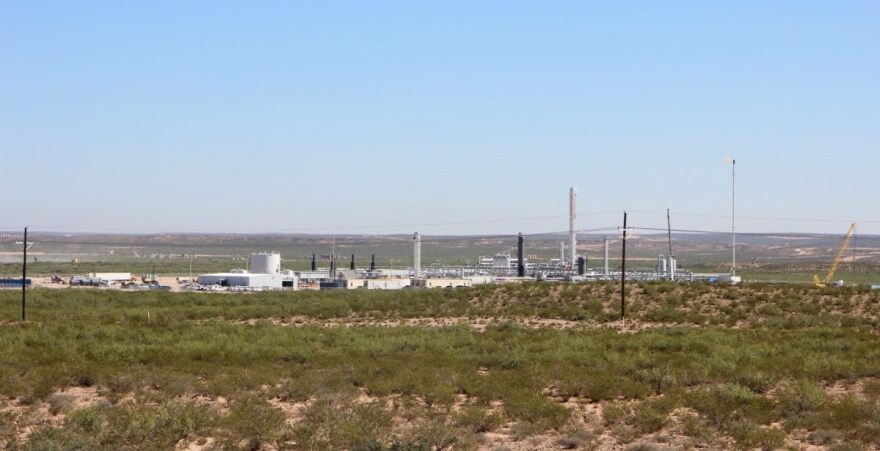Methane emissions in a busy part of the nation’s largest oilfield were nearly three times higher than the national average in recent months, an environmental group said in an analysis released Tuesday.
The finding from the advocacy group Environmental Defense Fund is the first notable datapoint in what will ultimately be a year-long project aimed at mapping emissions of the climate change-causing gas in the sprawling Permian Basin oilfield of West Texas and Southeastern New Mexico.
The group said Tuesday that its atmospheric scientists had used on-the-ground and aerial monitors to conclude that from October 2019 through March of this year, 3.5% of all the natural gas produced in a corner of the region straddling the Texas-New Mexico border was lost in the form of methane emissions.
That compares to a national methane “leak rate” of about 1.3% the group calculated by comparing federal emissions numbers from the Environmental Protection Agency with numbers on overall U.S. natural gas production.
“These are really significant emission rates,” Colin Leyden, an advocate with the EDF, said in an interview. “I think it shows a failure on the part of industry and regulators to protect communities and prevent waste.”
The EDF said it had found some wells in the region, known as the Delaware sub-basin, that released methane through leaks, malfunctions or direct releases called “venting” at more than 100 times the national rate.
“Oil and gas companies have a core responsibility to protect health, safety and the environment,” Matt Watson, an advocate who leads the group’s programs on the energy industry, said in a statement. “This data shows that operators in [the] Permian are failing to meet that basic obligation.”
The finding comes as the U.S. oil industry reels from the one-two punch of the coronavirus pandemic gutting global demand and a sweeping collapse in oil prices. With the bust still in its early stages, experts have offered conflicting ideas about whether the industry’s environmental footprint will fall along with its fortunes.
Analysts at Oslo-based Rystad Energy said Monday the downturn has already come with a “silver lining” – a drop in one form of emissions that contributes to the overall methane picture.
The firm said its estimates showed that total volumes of Permian Basin “flaring,” where producers burn off excess natural gas, have fallen to their lowest quarterly levels since late 2018. Flaring “intensity,” or the volume of gas burned off compared to the amount of gas produced overall, has “declined substantially” in the region the EDF is studying, Rystad said.
“Even without the potential shut-ins expected in 2Q20, oil production is expected to begin declining from the end of the current quarter,” the firm said. “Flaring will decline more quickly due to its strong correlation with new well counts.”
Earthworks, another environmental group not involved in the new methane mapping project, has challenged the Rystad figures, saying the numbers could be “illusory” because of the problem of “unlit flares” where gas spews straight into the air instead of being burned, like a stove’s pilot light going out without the gas turning off.
“Our hundreds of Permian field investigations over the past three years show a rising trend of unlit flares in the face of declining prices,” said Sharon Wilson, an Earthworks advocate who closely monitors emission in the region.
The International Energy Agency, a leading global research entity, said last week that while the coronavirus pandemic is likely to lead to a drop in global carbon dioxide emissions thanks to businesses and travel grinding to a halt, a similar drop in oilfield methane emissions isn’t guaranteed.
“For example, a decline in revenues from oil and gas operations could mean that companies pay less attention to efforts to tackle methane emissions,” the IEA said. “Low natural gas prices may lead to increases in flaring or venting, and regulatory oversight of oil and gas operations could be scaled back.”
The industry has taken steps to address the methane problem, launching a variety of state, federal and global-level programs where companies voluntarily agree to cut emissions. Some of the world’s largest oil companies have gone even further, pushing the Trump administration to abandon its plan to roll back Obama-era regulations on oilfield methane.
The EDF has echoed those oil giants, pushing for stronger federal methane rules, but Leyden said part of the problem in the Permian stems from natural gas simply being viewed as worthless.
“In a basin that’s producing a lot of gas but where the operators are primarily there for oil, it seems that more attention needs to be paid to the gas that’s coming up with that oil,” the EDF advocate said. “It’s also regulatory expectations, it’s nothing new to say that regulators in Texas need to spend a little bit more time being a watchdog and less time being a cheerleader.”

